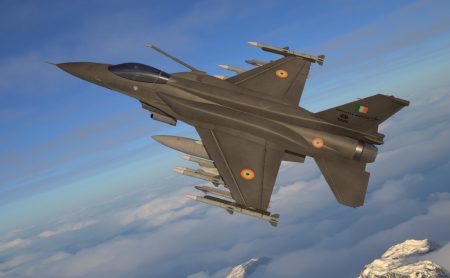Lockheed’s F-16 hard sell: Pros and cons of buying the American fighter
When Wing Commander Abhinandan Varthaman shot down an F-16 Falcon over Pakistan occupied Kashmir on February 27, it was a case of sheer bad timing for Lockheed-Martin. Just a week earlier, at the Aero India Show in Bangalore, the US aerospace giant had launched a repackaged F-16 as a brand new F-21 specifically for the Indian market.
With the seventies era Falcon getting smoked by an even older Soviet aircraft with an atrocious crash rate, Lockheed received a ton of flak for peddling old technology to the Indian Air Force.
There’s no getting around the fact that the aircraft Lockheed is pitching to India – in response to an IAF tender for 110 fighters – is not a new generation aircraft but only an upgraded F-16 that first flew in 1974. In aeronautical timeframe, that’s ancient history.
In its bid to win the Indian order, Lockheed has gone for pushy salesmanship, which is never a good tactic. It is an especially unwise move in India where corruption in the defence sector is deep-rooted, with a string of big-ticket contracts tainted by kickbacks. In this backdrop, the rebadged F-16 seems like an amateurish attempt to impress the Indian market.
Not just old wine ::
Lockheed should have retained the Falcon’s original badge with its latest iteration – the F-16 Block 70. For, the Falcon remains – 45 years after its first flight – a high-performance aircraft that becomes an even more potent weapon in the right hands.
In a mock combat exercise held in the US in 2016, an F-16 outgunned and outmanoeuvred the latest F-35, thoroughly humiliating the stealth fighter. More significantly, the Falcon was deliberately handicapped with a full load of missiles, bombs and fuel while the F-35 was flown clean – that is minus its missiles – for optimum performance and speed. And yet the F-16 won.
One must be careful not to read too much into the results of mock combat exercises because most of the data is classified and the media never really gets a full picture of what really happened. Whether Lockheed gamed the dogfight in order to impress the IAF may always remain a mystery.
However, the F-16 doesn’t need a hard sell because it has a great kill record, albeit against poorly trained air forces in the Middle East. The Israeli Air Force, for instance, has used the aircraft to strike its adversaries near its borders and has also destroyed targets as far as Tunisia and Iraq.
Also, it’s a myth that F-16 production lines are closing in the US. Defense Industry Daily reported that on April 23 Lockheed-Martin opened a new line in South Carolina with Block 70 production scheduled for later this year. Earlier, in March, Lockheed announced the establishment of the first F-16 maintenance facility for foreign-owned Falcons, in Norway.
One must not forget that as many as 3,000 operational F-16s are in service in 25 countries, and the company expects the new production line to build at least 400 more aircraft.
Also, with the ongoing troubles with the F-35 programme, the Falcon remains the backbone of the US Air Force, which operates 1,235 of these fighters.
Lockheed’s India strategy ::
The IAF global tender to buy 110 aircraft could easily dwarf the $8 billion Rafale order. Janes reported the order could be worth at least $15 billion, making it India’s largest defence order ever. According to the terms of the bid, 17 fighters are to be delivered flight-ready, while the remaining 93 would be produced in India. The document also specifies 82 of the aircraft should be single-seat, with the rest being dual-seat jets for pilot training.
In this backdrop, Lockheed’s announcement that it would shift the F-16’s entire production chain to India and manufacture the jet fighter jointly with Tata Advanced Systems Limited looks like a game changer in the global aerospace industry.
If the deal gets the government’s green light – and provided Lockheed is able to deliver the goods – it would be the first time in the modern armaments history that an entire aircraft ecosystem is transplanted in a different country.
The Block 70 that Lockheed has offered India is the latest version, with extended range. With upgrades, the F-16 will, in all probability, be flying in the second half of this century. Some predict that it could be the world’s first 100-year-old fighter. With its airframe showing no signs of fatigue, it could fulfil that prediction. Clearly, this is an aircraft with a long shelf life.
Lockheed India Vice President Vivek Lall said at Aero India that the aircraft comes with “greater standoff capability, greater staying power with less fuel burn, and network data linking capabilities across all platforms”. The aircraft also has an active electronically scanned array radar, which has detection ranges nearly double that of previous mechanically scanned array radars and the ability to track and attack more targets with higher precision.
It also has an advanced electronic warfare (EW) system that provides enhanced survivability against ground and air threats; and long-range infrared search and track (currently only available in the Sukhoi Su-30MKI), enabling pilots to see threats without being detected.
The IAF is making rapid strides towards becoming a fully networked force. Its new emerging network architecture includes the Operational Data Link, the Integrated Air Command and Control System and Air Force Net. These networks when merged create what is known as sensor fusion, providing a complete picture of the battlespace out to hundreds of kilometres. Unlike older jets like the MiG-21, the F-16 can tap into this network and round out its surveillance picture.
PAF factor ::
Since the Pakistan Air Force flies several squadrons of older F-16s, there is an unease in certain quarters about its induction in the IAF. These fears are misplaced. Both Indian and Pakistani pilots are aware of the strengths and weakness of each other’s aircraft.
IAF pilots routinely fly with USAF pilots in their F-16s during mock combat exercises. (Similarly, the PAF may have obtained data on Sukhois from Indonesia, Malaysia and the fountainhead of all leaks, Ukraine.)
The only downside of having the Falcon on both sides of the border is that air defence forces will have a hard time, especially when fighter aircraft are on missions with their IFF (identify friend or foe) systems switched off.
Also, since the average dogfight lasts under 10 minutes, things can get real ugly in the heat of combat. Fratricide is often the result. To illustrate, it was an Indian air defence unit that brought down an Indian helicopter during the February 27 skirmish.
However, Pakistan which has a weaker air defence system will face the bigger problem. Don’t forget that after the Balakot air strikes and the February 27 air battle over J&K, Pakistan’s airspace was closed for more than two weeks. Despite the hardship faced by domestic travellers and the huge economic consequences, Pakistan kept its airspace closed.
The reason for the bizarre fly ban was that the entire Pakistani defence establishment was spooked by the Indian raid – the first in 48 years. The only way Pakistan could reliably identify enemy jets was if there was zero civilian movement in its airspace. So in a situation with over a hundred F-16s on the Indian side of the border, you can well imagine the PAF’s plight.
And now the bad news ::
Manufacturing the F-16 in India carries with it the danger that the defence import lobby would use it as an excuse to kill off the Tejas. The indigenous fighter, which has been wowing aviation experts and enthusiasts at air shows worldwide, is on the cusp of becoming India’s first major armaments export.
If India places an order for the planned 110 fighters, there is the danger of the axe falling on the Tejas. With a limited share of the defence budget, the IAF may not have the cash to splurge on two separate fighter programmes. As long as the air force brass are assured they’ll get sufficient numbers of modern battle tested F-16s – or any other modern foreign fighter – they may not care what happens to the Tejas.
There is a precedent for this. In the 1960s, with German collaboration, Hindustan Aeronautics Limited (HAL) India had developed the HF-24 Marut fighter. During the 1971 War, the IAF had enough confidence in the Marut to send it on bombing missions deep into the Pakistani airspace. For a fighter developed on a budget, it produced reasonably good results.
However, just as the Marut programme appeared to take off, the Soviets offered India the MiG-21 interceptor. Moscow also sweetened the deal through long-term, low-interest loans and also allowed licence production. With HAL factories around the country saddled with MiG production lines, the public sector aircraft maker was ordered to kill the Marut. It took another 50 years before HAL would make another indigenous fighter, the Tejas.
Why licence production is a dead end ::
India’s state-owned defence industry has for decades been addicted to licence production, which in plain language means screwdriver technology. In a paper titled ‘Transfer of Defence Technology – Exploring the Avenues for India’, the Institute for Defence Studies and Analyses (IDSA) explains why licence production or manufacture is a technological dead end.
“The licence manufacture mode, currently being referred to as transfer of technology in the Indian Defence Procurement Procedure, essentially delivers the capability to manufacture or produce defence systems through the acquiring of necessary knowhows. However, for significantly upgrading the system or designing, developing and manufacturing new variants independently of the foreign technology seller firms, the know-whys are needed. These know-whys are never provided for established reasons and huge costs, leaving the recipient country considerably dependent on the seller firm for its futuristic needs.”
In the last five decades, India has licence produced a number of aircraft (MiG-21, MiG-27, Jaguar and the Sukhoi Su-30MKI), tanks (T-72 and T-90) and BMP armoured personnel carriers among others. And yet India’s state-owned companies did not develop a single new home-grown version of these weapons platforms.
Licence production, which India pioneered with the MiG-21, does not involve the transfer of technology and neither does it lead to innovation. The weapons system is pretty much frozen and much of its most critical parts are imported. For instance, the engines of the Su-30MKI are imported fully built from Russia, and in fact, a HAL Sukhoi costs more than a made in Russia one.
Making the Falcon in India ::
The F-16 could change that by ushering in a new era of technological advancement in India. To illustrate, when India took the first steps towards economic liberalisation, it was the re-entry of Coca-Cola that made India kosher for foreign multinationals. The presence of Coke, the defining symbol of Western capitalism, assured investors that India was dumping Soviet-inspired socialism and ready to do business again.
Similarly, Prime Minister Narendra’s Modi’s Make in India initiative in defence will receive a turbocharge if the Falcon lands in India. First up, there will be an immediate impact on the Indian aerospace industry. The entire process of transplanting an aircraft ecosystem could potentially create thousands of technical jobs. According to Lockheed executives, “it’s like bringing up a whole new industry”.
How Turkey rode the Falcon ::
A highly successful example of how the transfer of technology transformed a nation’s aerospace sector is the Lockheed-Turkish Air Industries (TAI) tie-up in the 1980s. According to the IDSA, this project resulted in the production of a total of 308 F-16 aircraft over a period of around 12 years.
In this landmark deal, the state-owned TAI had the major share with 49 per cent; Lockheed Martin had 42 per cent; General Electric (GE) had 7 per cent and the remaining was held by two other firms. A total investment of $137 million was made, with $70 million from Turkish partners and $67 million from the US partners, which was later supplemented by the latter with another $100 million. Lockheed Martin provided three experienced directors for five years and the general manager for 14 years.
“From the experience gained from building 80 per cent of the F-16 aircraft, TAI began branching out into other areas to include: parts of the transport aircraft CN-235 and A400M; modifications of Boeing 737s into an airborne early warning aircraft; and parts of helicopters Agusta Mangusta T-29 and Sikorsky T-70 Blackhawk. The TAI also developed a modification centre where they upgraded aircraft such as the C-130s, F-4s, T-38s and F-16s.”
Lockheed claims the Turkish company is now developing indigenously designed unmanned aerial vehicles, basic trainer aircraft and even a fifth generation fighter aircraft.
Rivals from Europe ::
Lockheed’s offer to move the F-16 production line to India does not guarantee the American company will walk away with the deal. It faces five rivals in the race – Boeing’s F/A-18 Super Hornet, Dassault Aviation’s Rafale, the Eurofighter Typhoon, Saab’s Gripen and the MiG-35 from Russia’s United Aircraft Corporation.
The Gripen is a dogged rival that has tasted success in South Africa, Czech Republic and Hungary. Saab has offered to move the Gripen plant from Sweden to India. It has offered the IAF an aircraft that is cheap as chips but is no laggard either when it comes to performance technology.
As well as highly developed net-centric warfare capabilities, the Gripen has good short takeoff performance. Plus, Saab has designed it to have low maintenance requirements, which could interest the IAF, whose Achilles heel is maintenance.
American influence ::
What tilts the balance in the F-16’s favour is geopolitics. An order this big is rarely about just price or performance – it is also about quid pro quo. Sweden is a geopolitical lightweight and there is very little it can offer in terms of swinging the balance of power in India’s favour.
However, with the US, India is in a position to extract its pound of flesh. As well as aerospace, New Delhi could nail down guarantees on the transfer of technology in other critical areas while also getting the US to align its diplomacy in line with India. India can ensure US support in isolating Pakistan, squeezing its economy and dismantling the terror state.
The F-16 order has the potential to bind India and the US in a long-term strategic alliance. It will also isolate the anti-India hawks in the State Department (the US foreign ministry) and the Pentagon where doddering pro-Pakistan generals – the detritus of the Cold War – continue to treat India with suspicion.
The deal will also ease the flow of technology and investment into India’s defence private sector. India being the technologically and economically weaker partner will derive greater gains from association with the likes of Lockheed.
Endgame ::
The 110 aircraft order is a crucial requirement of the service, which currently has a reduced strength of 31 fighter squadrons, whereas it requires 42 squadrons to tackle the collusive threat of Pakistan and China. With hundreds of antiquated MiGs due for retirement and HAL producing just around a dozen Tejas jets annually, the IAF doesn’t have the luxury of numbers or time.
Provided it doesn’t result in the cancellation of the Tejas fighter, Lockheed’s offer is a win-win for India. The IAF should speed up negotiations and user trials so a deal can be inked quickly. For, the danger is that India’s ponderous defence procurement machinery could drag the tender into the abyss – just like it did with the MMRCA.
Also Read:
Commands of the Indian Air Force explained in detail
Aircrafts acquired by Indian Air Force
Source: DefenceNews






 Order Now on Amazon
Order Now on Amazon
